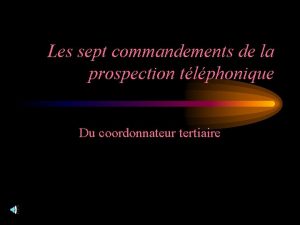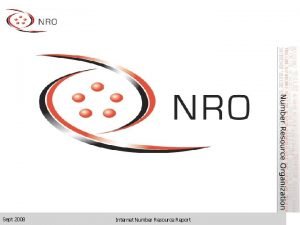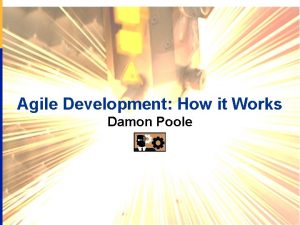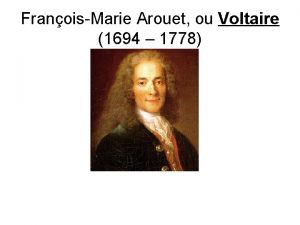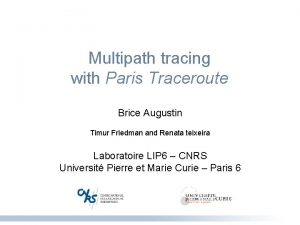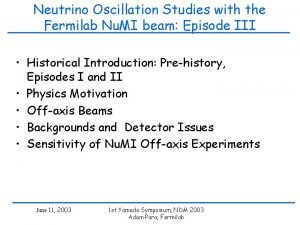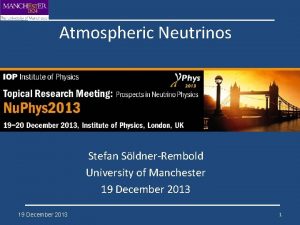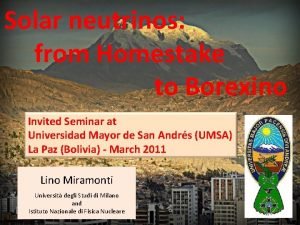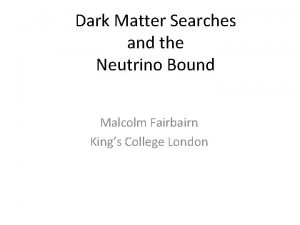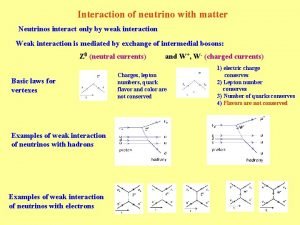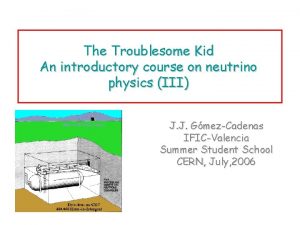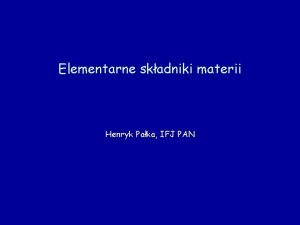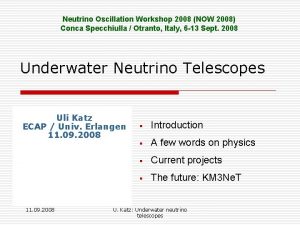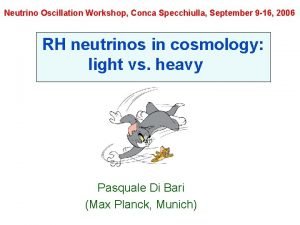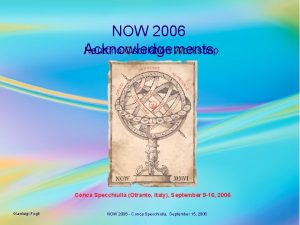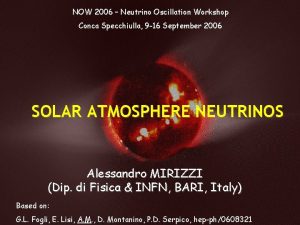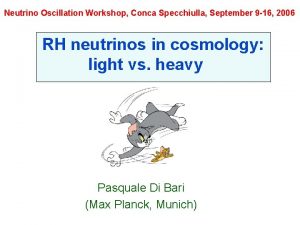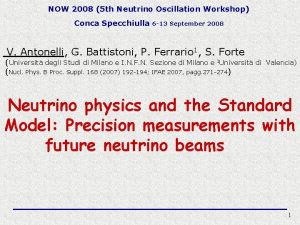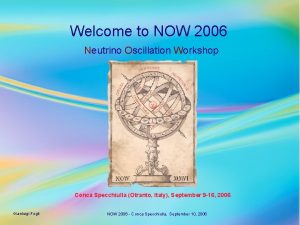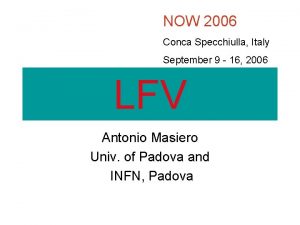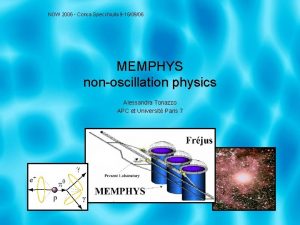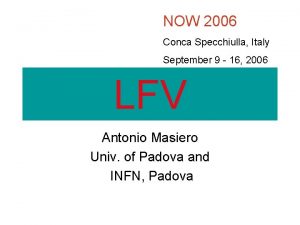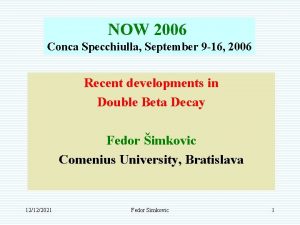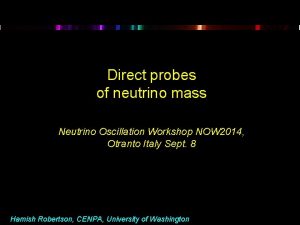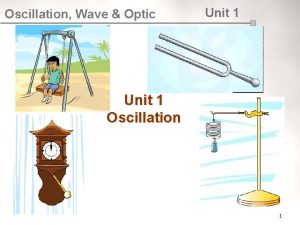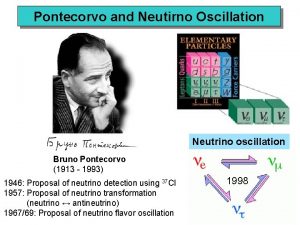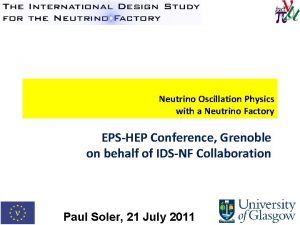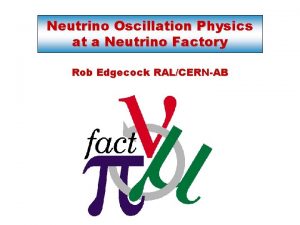NEUTRINO OSCILLATION WORKSHOP Conca Specchiulla 9 16 Sept























- Slides: 23

NEUTRINO OSCILLATION WORKSHOP Conca Specchiulla 9 -16 Sept. 2006 Geo-Neutrino: Theoretical Aspects Anna Maria Rotunno Dip. Di Fisica & Sez. INFN di Bari Based on: G. L. Fogli, E. Lisi, A. Palazzo, A. M. Rotunno, Geo. Neutrinos: an approach to their uncertainties and correlations, to appear in Earth, Moon and Planets; & long preprint in preparation (2006)

Purpose of this Work Geo-Neutrinos emitted by heat producing elements (U, Th, K) can probe Earth interior. Their fluxes present large and correlated uncertainties. Handling them is difficult but necessary, if we want to quantify how future data can reduce errors. - We propose an approach in terms of covariance matrices. - We briefly discuss the construction of a tentative Geo-Neutrino Source Model (GNSM) describing U, Th, K abundances in Earth reservoirs. - We show predictions about several experiments (“forward approach”) and how future data can constrain the error matrix of the model (“backward approach”). Contents - Introduction to Geo-Neutrinos - The Geo-Neutrino Source Model (GNSM) - Covariance and Correlation - Forward Analysis - Backward Analysis - Conclusions and Prospects

Introduction to Geo-Neutrinos

What do we know about Earth Interior? T = 4000 ºC T = 1500 ºC T = 3700 ºC T = 4300 ºC -Seismology: based on sound velocity measurement from seismic data - reconstructs density profile throughout the Earth - infers crust-mantle-core layer structure Fe-Ni, S, O, H, etc. (Mg, Fe, Al) (Al, Si)O 2 pervoskite Ca. Si. O 2 pervoskite, (Fe, Mg)O -Geo. Chemistry: based on direct sampling - gives direct information on chemical composition of crust and upper part of mantle - does not reach deep Earth

-The mantle convects even though it is “solid”. - Main issue today: Whole or layered mantle convection?

- Earth’s Global Heat: - 30 – 45 TW: not well constrained due to scarce oceanic sampling and model dependence - probably 40 – 60% has radiogenic origin: mainly from decays of 238 U, 232 Th, 40 K (trace elements) inside crust and mantle Geo-Neutrinos bring to surface information about: - the whole planet - its radioactive contents - energetics and thermal history 238 U 232 Th counts/Me. V/parent from radioactive decays of 238 U, 232 Th, 40 K trace elements in crust and mantle of Earth series 40 K anti-neutrino energy E (Me. V) Where are radioactive elements located?

“Standard Model” of Earth Global Composition in Trace Elements 4. 5 GY ago Original Earth global composition similar to Carbonaceous Chondrites (CI) Oldest meteorites ≡ undifferentiated rock and metal mixture - Escape of volatile elements (e. g. K) - Crust/Mantle(Upper/Lower Mantle) Differentiation Planetary Evolution: - Refractory Lithophile elements (e. g. U, Th) differently distributed in crust and mantle Today’s Earth composition is not CI ! Bulk Silicate Earth (BSE) Model describes assumes Constraints: - “primitive mantle” - present crust+mantle system - Earth Refractory Elements in chondritic proportions - U, Th, K absent in the Earth core Direct sampling (crust & upper mantle) Low (<1200 K) condensation temperature High (>1400 K) condensation temperature Preferentially embedded in rocks rather than iron i. e. before crust/mantle differentiation Th/U abundance ratio is 3. 9 & Neutrino Geophysics (in the future)

A recent new field in Neutrino Physics: Geo-Neutrino detection by Liquid Scintillator 2005: first Geo– e observation at Kam. LAND Coll. , Nature 436, 499 (2005) Sea of Japan Kam. LAND Japan Trench Some Important Facts: - Observable Geo- e events: from U, Th decay only - e from K decay below threshold for detection - FTh( e) & FU( e) in Kam. LAND weighted by 1/L 2 - U, Th, K more abundant in the crust than in the mantle - Assumptions on the relative Th, U (and K) abundances need to be explicitly reported Th/U = 3. 8 - Earth science constraints - Uncertainty evaluation our reanalysis of Kamland data In this context we illustrate our approach to uncertainties and correlations

Question 1: What do we really know about U, Th, K abundances? Question 2: What do we expect to know from geo- data? Usually advertised Goal: measure the Earth Radiogenic Heat But…. … based on future U and Th geo- flux measurements, we might say something more (e. g. , about mantle convection) We report about a systematic approach to include U, Th and K abundance uncertainties and correlations in reservoirs (“Geo-Neutrino Source Model”)

The Geo-Neutrino Source Model (GNSM)

GNSM Structural Details Purpose: to incorporate the best available knowledge of U, Th and K distributions inside Earth. Our GNSM geometry is based - PREM model (Dziewonsky & Anderson, 1981): spherical symmetry of Earth below crust - CRUST 2. 0 model (G. Laske et al. , 2001): crustal characterization on a 2° grid. Global reservoirs: - core - lower mantle - upper mantle - continental crust - oceanic crust Local reservoirs: lower/middle/upper crust around detector sites that are: - Japan (Kam. LAND) 13 crustal tiles - Hawaii - BOREXINO 9 crustal tiles - SNO - LENA Local composition may be ≠ from global composition (in terms of U, Th, K) on:

GNSM geochemical details: {ai. S}i=1, …N (S=U, Th, K) a = {ai}i=1, … 3 N , N = number of reservoirs set of abundances (i. e. abundance vector) of reservoirs, ai: a i = a i ± i and [ 2]ij = ij i j where ai = central value, 2 = covariance matrix, = error correlation matrix. Entries for the above equations: -BSE Model: gives global constraints on elemental abundances (“mass balance constraints”) -Vertical crust structure: relevant within local reservoirs -Missing information is supplied by educated guesses, whenever possible, or arbitrary but explicit assumptions, when unavoidable -“local” abundance fluctuations assumed to be decoupled from “global” abundance uncertainties For abundance values and references, we refer to G. L. Fogli, E. Lisi, A. Palazzo, Geo. Neutrinos: an approach to their uncertainties and correlations, to appear in Earth, Moon and Planets

An example: U, Th, K uncertainties and correlations in BSE For Uranium, Thorium: - a. BSE/a. CI expected to be the same for all Refractory Lithophile Elements not volatilized during Earth formation (e. g. U, Th, Al) - Benchmark: Alluminium more abundant than trace elements U, Th Sources: We obtain: a. Th BSE = a. Th Al Al CI (a BSE/a CI) a. UBSE = a. UCI (a. Al. BSE/a. Al. CI) U, Th. BSE= 0. 936 (U, Th) correlation - CI meteoritic data (1988 -2003) - recent BSE models: Mc. Donough & Sun (1995) Allegre et al. (2001) Palme & O’Neill (2003) - relative U & Th abundances in CI from Ref. Rochall & Jochum (1993), Goreva & Burnett (2001) For Potassium: - K not constrained by meteorites, because moderately volatile - we conservatively increase the K/U ratio error usually quoted in the geochemical literature (Ref. Jochum et al, 1983) because unrealistic We obtain a. KBSE , K, Th. BSE = 0. 648 & K, UBSE = 0. 701 Similarly, we survey all the available literature for upper mantle (UM), continental crust (CC) and oceanic crust (OC) to estimate abundances (central values), errors and correlation

Lower Mantle (LM) not accessible! Qualifying result of our work Derived by mass balance constraints - LM abundance obtained by subtraction: LM = BSE–UM–CC–OC - Derivation of errors (by propagation) and correlations Structure of correlation matrix of abundance Global Reservoirs (correlated) OC CC UM LM UM CC = continental crust OC = oceanic crust UM = upper mantle LM = lower mantle LM (core is excluded) OC CC U Th K U Local Reservoirs (uncorrelated) i-th reservoir ≡ Th K “local” fluctuations have nothing to do with “global” estimates LM abundances anti-correlated with the other reservoirs because of subtraction

Numerical Results Geo-Neutrino Source Model (GNSM): Abundances, errors and correlations of radiogenic elements (U, Th, K) in global reservoirs Geo-Neutrino Source Model for Global Reservoirs ± 1 U Th U 21. 9× 10 -9 ± 14 % 1 Th 82. 1× 10 -9 ± 14 % K 26. 3× 10 -5 ± 21 % U 1. 46× 10 -6 ± 17 % Th 6. 29× 10 -6 ± 10 % K 1. 62× 10 -2 ± 10 % U 1. 00× 10 -7 ± 30 % Th 2. 20× 10 -7 ± 30 % K 1. 25× 10 -3 ± 28 % U 3. 95× 10 -9 ± 30 % Th 10. 8× 10 -9 ± 30 % K 5. 02× 10 -5 ± 28 % U 17. 3× 10 -9 ± 30 % Th 60. 4× 10 -9 ± 30 % K 21. 7× 10 -5 ± 28 % Reser. Elem. Abund. BSE CC OC UM LM BSE CC OC K U Th +. 936 +. 701 0 0 1 +. 648 0 0 1 0 0 0 1 +. 906 1 Similar to previous work by Enomoto et al. , Fiorentini et al. UM LM K U Th K 0 0 0 +. 908 +. 893 +. 690 0 0 +. 850 +. 954 +. 638 0 0 0 +. 636 +. 618 +. 985 +. 906 0 0 0 -. 409 -. 263 -. 146 +. 595 0 0 0 -. 371 -. 291 -. 096 1 0 0 0 -. 371 -. 173 -. 161 1 +. 906 +. 868 0 0 0 -. 012 -. 007 1 +. 764 0 0 0 -. 011 -. 006 1 0 0 0 -. 010 -. 006 -. 008 1 +. 906 +. 868 -. 093 -. 065 -. 058 1 +. 764 -. 084 -. 071 -. 051 1 -. 081 -. 054 -. 066 1 +. 924 +. 692 1 +. 640 1 NEW Qualifying result of our work allows well-defined statistical analyses

Covariance approach relevant for Geo. Neutrino physics because: - All relevant observables and constraints can be expressed as linear functions of such abundances (with known coefficients) - (U, Th, K) abundances within a given reservoir are typically positively correlated - (U, Th, K) correlations among different reservoirs can take any value > 0 local abundances ij < 0 complementary reservoirs ~ 0 decoupled reservoirs - Measured Geo-Neutrino event rates (RU, RTh) are anticorrelated our reanalysis of Kamland data Solid line: Kam. LAND data fit Dashed line: Adapted Gaussian RTh (TNU) RU = 12. 5 ± 48. 9 TNU RTh = 34. 7 ± 28. 5 TNU (U, Th) = - 0. 645 RU (TNU) 1 TNU = 1 event/year/1032 protons Negative correlation due to experimental sensitivity to RU +RTh rather than RU and RTh separately

Forward Analysis: Event Rates at Kam. LAND Dashed Line: Kam. LAND data RU = 12. 5± 48. 9 TNU RTh = 34. 7± 28. 5 TNU (U, Th) = -0. 645 Solid Line: GNSM RU = 24. 9± 2. 0 TNU RTh = 6. 7± 0. 5 TNU (U, Th) = 0. 901 - GNSM compatible with data at 1. - Data do not constrain model yet. - Background reduction and much higher statistics required. Th/U = 3. 8

Forward Analysis: Total Event Rates (including oscillations) with errors and correlations at various detector sites Site Rate ± 1 (TNU) Kamioka 31. 6 ± 2. 5 Gran Sasso 40. 6 ± 2. 9 Sudbury 47. 9 ± 3. 2 Pyhasalmi 49. 9 ± 3. 5 Baksan 50. 7 ± 3. 4 Hawaii 13. 4 ± 2. 2 Correlation Matrix of GNSM predictions Kamioka Gran Sasso Sudbury Phyasalmi Baksan Hawaii 1. 00 0. 72 0. 65 0. 63 0. 62 0. 83 1. 00 0. 71 0. 73 0. 70 0. 64 1. 00 0. 69 0. 65 0. 55 1. 00 0. 69 0. 48 1. 00 0. 51 1. 00 all positively correlated (they measure in part the same flux)

Forward Analysis: Total Radiogenic Heat vs Total Event Rate at Kam. LAND GNSM RU+Th = 31. 6 ± 2. 5 TNU HU+Th+K = 21. 1 ± 3. 0 TW (R, H) = +0. 858 The ellipse selects the allowed band of total radiogenic heat around GNSM prediction

Mantle Convection Problem: still debated today Two extremes: 1) homogeneous mantle: whole mantle convection, i. e. a. LM= a. UM 2) two-layered model: geochemically decoupled UM and LM LM with primitive abundances a. LM= a. BSE 1, 2, 3 Within 3 : GNSM - a. LM two-layered whole mantle convection GN SM homogeneous a. UM (left panel) - a. LM a. BSE (right panel) two-layered mantle model GNSM central values: a. UM < a. LM < a. BSE partial mantle convection The two extreme cases are recovered at ± 3 in our GNSM

Backward Analysis: Hypothetical future Results about Mantle Convection In an optimistic future scenario with: - 6 detectors operative - U, Th event separate collection for 20 kton years - no background - no systematics + DATA In principle, it might allow to reject at >> 3 the case a. LM = a. UM (global mantle convection). Really relevant result in geophysics and geochemistry More realistic (or less optimistic) simulations of prospective data need to be performed. partial convection preferred

We expect that a network of detectors in different points of the Earth’s continental and oceanic crust would be useful to: - REDUCE THE EXPERIMENTAL ERROR; - CONSTRAIN THE GNSM PARADIGM NEW EXPERIMENTS in sites with both LOWER & HIGHER FLUX - BOREXINO - LENA - Sudbury - Hawaii - Baksan We are currently studying the synergy of a world detector network from a quantitative viewpoint.

Conclusions and Prospects - We have presented a tentative Geo-Neutrino Source Model (GNSM) embedding a full error matrix for the (U, Th, K) abundances in relevant local and global reservoirs. It is based on published data (when available) and on supplementary assumptions (when needed). - Covariance analysis may provide a useful template for current and future studies. Applications of our approach have been given in terms of predictions for future experiments (forward propagations of errors) and of GNSM error reduction through prospective data (backward update). - We are still far from a satisfactory approach of this kind in (U, Th, K) geochemistry, due to intrinsic difficulties (large uncertainties, incomplete data, sometimes conflicting estimates, ecc. ) - Interdisciplinary studies of more refined geochemical and geophysical Earth models and of future possible observations of Geo-Neutrino signals will be beneficial to Earth sciences.
 Sept commandements
Sept commandements Ectomy examples
Ectomy examples Les sept collines de jérusalem
Les sept collines de jérusalem Cnn 10 september 7th
Cnn 10 september 7th Un deux trois quatre cinq six sept huit neuf
Un deux trois quatre cinq six sept huit neuf Sept
Sept Les arbres des villes georges drouillat
Les arbres des villes georges drouillat Sept heure moins le quart
Sept heure moins le quart La guerre de sept ans
La guerre de sept ans I sept
I sept Ecrivez les sept jours de la semaine
Ecrivez les sept jours de la semaine Accu poole sept
Accu poole sept Candide ou l optimisme
Candide ou l optimisme Sept comme setteur questionnaire
Sept comme setteur questionnaire Paris traceroute
Paris traceroute Neutrino
Neutrino Neutrino
Neutrino Solar neutrino
Solar neutrino Neutrino
Neutrino Leptons
Leptons Neutrino interaction with matter
Neutrino interaction with matter Dotterkärna
Dotterkärna Neutrino
Neutrino Lekka cząstka elementarna mion elektron lub neutrino
Lekka cząstka elementarna mion elektron lub neutrino
